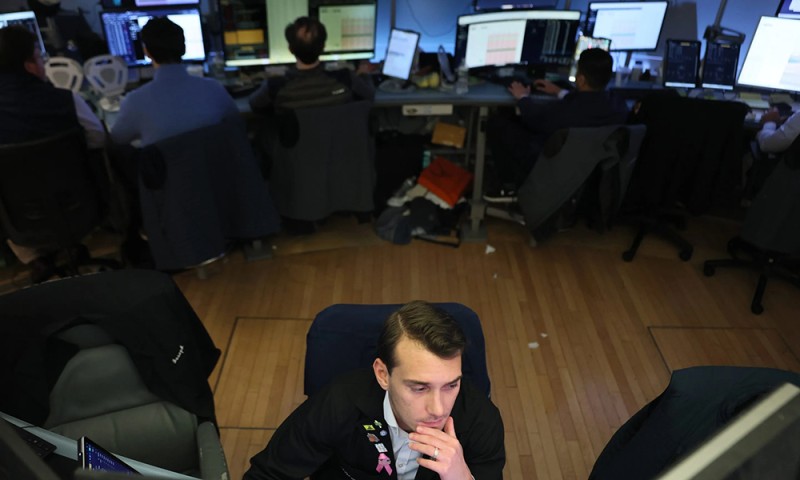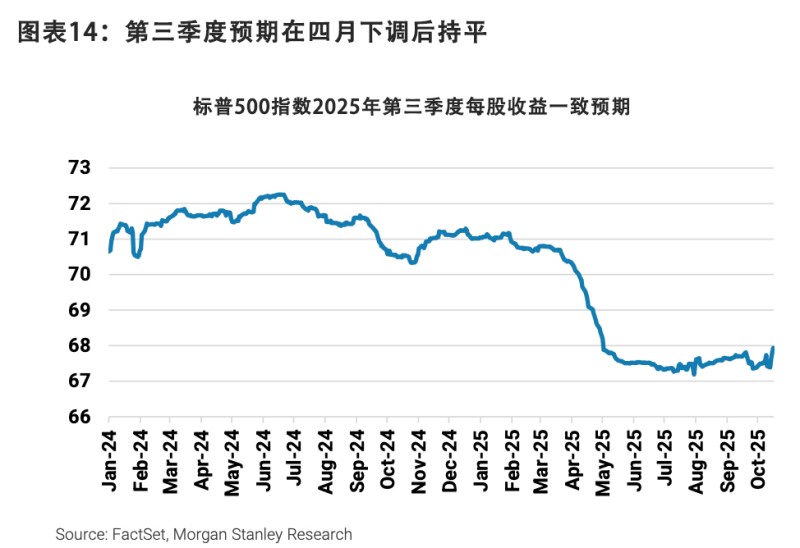
多年来,当经济学家们只关注GDP增长时,摩根士丹利(Morgan Stanley)首席股票分析师迈克·威尔逊一直认为美国处于“滚动式衰退”。自四月起,他开始宣称美国正步入“滚动式复苏”,经济繁荣的早期迹象正逐渐在各个行业显现。
2025年以来,美国经济持续超预期上行,印证了他的乐观看法,尽管怀疑论者警告,关税影响和更广泛的宏观经济不确定性迟早会在数据中显现。威尔逊周一写道,“三季度财报让他略感迟疑:他并非认为自己的观点有误,而是注意到投资者在消化市场现状时显得紧张不安。从我们的交流来看,这仍是一个非共识观点。”
“市场持续震荡,”威尔逊周一写道,并补充说“未解决的风险”正沉重压在交易员心头。他的讨论主要围绕多数公司并未大幅上调业绩指引这一事实;市场预期仍维持在四月“解放日”关税公告后的低位。他还提到10月16日周中的市场暴跌,当时中型银行公布的业绩远逊于华尔街同行,促使摩根大通(JPMorgan)首席执行官杰米·戴蒙(Jamie Dimon)称之为“蟑螂时刻”:“当你看到一只蟑螂时,很可能还有更多。”
威尔逊坚持认为,美国经济正迎来“滚动式复苏”,未来六到十二个月将出现早期周期反弹。他周一写道,尽管当前市场波动且投资者情绪低迷,他的观点仍未改变。他提出,如果贸易紧张局势缓解、每股收益(EPS)预期趋于稳定,加之流动性改善,将为股市强劲反弹奠定基础。政策进展,包括即将召开的亚太经合组织(APEC)峰会上的预期贸易谈判,被视为潜在催化剂。然而,威尔逊补充说,他正警惕股市“近期进一步回调”,即在宣布“全面向好”之前,股价可能出现令人不安的暴跌。他列举了近期的信贷市场压力、融资波动,以及几家机构意外信贷损失后地区银行再度受到审视。
信号不一:强劲预期遭遇疲软盈利
财报季刚刚开始,金融板块尤其受到关注。初步结果显示,每股收益整体超预期幅度稳健,平均接近6%,高于历史常态。然而市场反应冷淡,即便业绩超预期,股价也反应平淡甚至下跌——这种异常模式被许多人归因于持续的宏观不确定性。简言之,企业业绩超出预期,但投资者远未被说服,尤其是在地区银行和资本货物等经济敏感领域,潜在风险依然存在。
尽管顶尖分析师描绘出复苏在即的图景,但与更广泛投资界的看法相比,他们的观点明显“非共识”。背景是个股特异性风险处于历史高位。盈利预期修正的分化也在加剧,这为熟练的选股者提供了良机,但也凸显了当前市场普遍存在的不确定性。
投资者焦虑:波动、信贷担忧与估值
整体市场情绪依然谨慎。上周,在新的贸易政策不确定性中,被称为华尔街恐慌指标的VIX指数飙升至四月以来最高点,随后有所回落。标普500指数盈利修正广度等指数级指标已从早前高点回落,但仍符合典型季节性模式。回归分析表明,标普500指数在当前盈利水平上估值合理;然而,除非市场热议的下一轮“上涨行情”成为现实,否则盈利动能的任何进一步减退都可能对股市构成沉重压力。
投资者的一个关键担忧是地区银行的困境,它们在披露意外信贷支出后股价表现不佳。这进而引发忧虑:市场中最敏感经济领域之一的问题可能蔓延或需要更多内部审查,在情况更明朗之前,金融股将陷入僵局。年初至今,地区银行和另类资产管理公司股票表现持续疲软,更广泛地说,市场大片领域仍陷于避险情绪中。
前路:机遇与风险
尽管存在这些 headline 风险,威尔逊并未放弃其看涨观点。他的团队指出了多个展现韧性的领域:邮轮预订需求强劲直至2027年、广告收入回升、科技行业在AI驱动下持续增长、企业差旅状况优于预期,以及消费者支出前景虽不均衡但令人鼓舞。威尔逊还指出,临近年末,公司可能更容易达到预期,因为尽管它们在近期财报中未大幅上调指引“并不典型”,但指引早在四月已被下调并保持平稳至今。因此,要跨越的门槛可能较低。

然而,要让投资者同样乐观,必须清除几道障碍:贸易紧张局势明确缓和、盈利预期修正趋于稳定、市场流动性持续改善。在此之前,分析师的乐观与投资者的疑虑之间的张力,将决定2026年前市场的基调。(*)
《财富》杂志使用生成式人工智能完成初稿。在发布前,编辑已核实信息准确性。
译者:中慧言-王芳
多年来,当经济学家们只关注GDP增长时,摩根士丹利(Morgan Stanley)首席股票分析师迈克·威尔逊一直认为美国处于“滚动式衰退”。自四月起,他开始宣称美国正步入“滚动式复苏”,经济繁荣的早期迹象正逐渐在各个行业显现。
2025年以来,美国经济持续超预期上行,印证了他的乐观看法,尽管怀疑论者警告,关税影响和更广泛的宏观经济不确定性迟早会在数据中显现。威尔逊周一写道,“三季度财报让他略感迟疑:他并非认为自己的观点有误,而是注意到投资者在消化市场现状时显得紧张不安。从我们的交流来看,这仍是一个非共识观点。”
“市场持续震荡,”威尔逊周一写道,并补充说“未解决的风险”正沉重压在交易员心头。他的讨论主要围绕多数公司并未大幅上调业绩指引这一事实;市场预期仍维持在四月“解放日”关税公告后的低位。他还提到10月16日周中的市场暴跌,当时中型银行公布的业绩远逊于华尔街同行,促使摩根大通(JPMorgan)首席执行官杰米·戴蒙(Jamie Dimon)称之为“蟑螂时刻”:“当你看到一只蟑螂时,很可能还有更多。”
威尔逊坚持认为,美国经济正迎来“滚动式复苏”,未来六到十二个月将出现早期周期反弹。他周一写道,尽管当前市场波动且投资者情绪低迷,他的观点仍未改变。他提出,如果贸易紧张局势缓解、每股收益(EPS)预期趋于稳定,加之流动性改善,将为股市强劲反弹奠定基础。政策进展,包括即将召开的亚太经合组织(APEC)峰会上的预期贸易谈判,被视为潜在催化剂。然而,威尔逊补充说,他正警惕股市“近期进一步回调”,即在宣布“全面向好”之前,股价可能出现令人不安的暴跌。他列举了近期的信贷市场压力、融资波动,以及几家机构意外信贷损失后地区银行再度受到审视。
信号不一:强劲预期遭遇疲软盈利
财报季刚刚开始,金融板块尤其受到关注。初步结果显示,每股收益整体超预期幅度稳健,平均接近6%,高于历史常态。然而市场反应冷淡,即便业绩超预期,股价也反应平淡甚至下跌——这种异常模式被许多人归因于持续的宏观不确定性。简言之,企业业绩超出预期,但投资者远未被说服,尤其是在地区银行和资本货物等经济敏感领域,潜在风险依然存在。
尽管顶尖分析师描绘出复苏在即的图景,但与更广泛投资界的看法相比,他们的观点明显“非共识”。背景是个股特异性风险处于历史高位。盈利预期修正的分化也在加剧,这为熟练的选股者提供了良机,但也凸显了当前市场普遍存在的不确定性。
投资者焦虑:波动、信贷担忧与估值
整体市场情绪依然谨慎。上周,在新的贸易政策不确定性中,被称为华尔街恐慌指标的VIX指数飙升至四月以来最高点,随后有所回落。标普500指数盈利修正广度等指数级指标已从早前高点回落,但仍符合典型季节性模式。回归分析表明,标普500指数在当前盈利水平上估值合理;然而,除非市场热议的下一轮“上涨行情”成为现实,否则盈利动能的任何进一步减退都可能对股市构成沉重压力。
投资者的一个关键担忧是地区银行的困境,它们在披露意外信贷支出后股价表现不佳。这进而引发忧虑:市场中最敏感经济领域之一的问题可能蔓延或需要更多内部审查,在情况更明朗之前,金融股将陷入僵局。年初至今,地区银行和另类资产管理公司股票表现持续疲软,更广泛地说,市场大片领域仍陷于避险情绪中。
前路:机遇与风险
尽管存在这些 headline 风险,威尔逊并未放弃其看涨观点。他的团队指出了多个展现韧性的领域:邮轮预订需求强劲直至2027年、广告收入回升、科技行业在AI驱动下持续增长、企业差旅状况优于预期,以及消费者支出前景虽不均衡但令人鼓舞。威尔逊还指出,临近年末,公司可能更容易达到预期,因为尽管它们在近期财报中未大幅上调指引“并不典型”,但指引早在四月已被下调并保持平稳至今。因此,要跨越的门槛可能较低。
然而,要让投资者同样乐观,必须清除几道障碍:贸易紧张局势明确缓和、盈利预期修正趋于稳定、市场流动性持续改善。在此之前,分析师的乐观与投资者的疑虑之间的张力,将决定2026年前市场的基调。(*)
《财富》杂志使用生成式人工智能完成初稿。在发布前,编辑已核实信息准确性。
译者:中慧言-王芳
Morgan Stanley chief equity analyst Mike Wilson has been saying for years the U.S. was in a “rolling recession” when economists were seeing nothing but GDP growth. Since April, he's been declaring a “rolling recovery,” with the early stages of an economic boom working its way through various sectors in the economy.
His optimism has been borne out by an economy that has surprised to the upside consistently throughout 2025, with skeptics warning the impact of tariffs and wider macroeconomic uncertainty would surely show up soon in the data. Third-quarter earnings are giving Wilson a little bit of pause, he wrote on Monday: It's not that he thinks his thesis is wrong, he's just noting investors are jittery as they digest the state of play. “This remains an out-of-consensus view from our conversations.”
“Markets remain choppy,” Wilson wrote on Monday, adding “unresolved risks” are weighing heavily on traders' minds. Much of his discussion centered on the fact that most companies simply aren't raising guidance much; the outlook remains ratcheted down to where it settled after April's “Liberation Day” tariff announcement. He also discussed the midweek swoon on Oct. 16 as midsize banks disclosed much cloudier earnings than their Wall Street counterparts, prompting JPMorgan CEO Jamie Dimon to describe a “cockroach” moment: “When you see one cockroach, there are probably more.”
Wilson maintains the U.S. economy is poised for a “rolling recovery” with an early-cycle rebound playing out over the next six to 12 months. He wrote on Monday his thesis remains intact despite current volatility and tepid investor sentiment. If trade tensions de-escalate and earnings per share (EPS) revisions stabilize, combined with improved liquidity, that could set the stage for a powerful upswing in equities, he argued. Policy developments, including anticipated trade negotiations at the upcoming APEC summit, are seen as potential catalysts. However, Wilson added, he's on guard for a “further near-term correction,” in other words, a sickening lurch downward in stocks, before declaring “all clear” for stocks. He cited recent credit market stress, funding volatility, and renewed scrutiny of regional banks after surprise credit losses at several institutions.
Mixed signals: Strong forecasts meet shaky earnings
Earnings season has just begun, with a particular focus on the financial sector. Early results show total EPS surprises are solid, averaging almost 6%, above the historical norm. Yet the market's reaction has been lukewarm, with stock prices showing muted-to-negative responses even after earnings beats—an unusual pattern that many chalk up to persistent macro uncertainty. In short, companies are beating expectations, but investors appear far from convinced, especially in economically sensitive sectors like regional banks and capital goods, where underlying risks linger.
While top analysts are painting a picture of imminent recovery, their view is notably “out of consensus” compared with the broader investment community. The backdrop is a historically elevated level of stock-specific risk. Dispersion in earnings revisions is also rising, pointing to a strong opportunity for skilled stock pickers, but also underlining the level of uncertainty that permeates the current market.
Investor anxiety: Volatility, credit fears, and valuations
The mood in the broader market remains cautious. Last week, the VIX—Wall Street's fear gauge—spiked to its highest level since April before easing, amid new trade policy uncertainties. Index-level measures, such as the S&P 500's earnings revisions breadth, have retreated from earlier highs but remain in line with typical seasonal patterns. Regression analyses suggest the S&P 500 is fairly valued at current earnings levels; nonetheless, any further pullback in earnings momentum could weigh heavily on equities unless the much-discussed next “leg higher” materializes.
A key concern among investors is the beleaguered position of regional banks, which have seen their stock prices underperform after disclosures of unexpected credit charges. This, in turn, has led to worries that problems in one of the most economically sensitive corners of the market could either spread or require more internal reviews, keeping financial stocks in limbo until there is greater clarity. Year to date, both regional banks and alternative asset manager stocks remain weak performers, and more broadly, large swaths of the market are still trapped in a risk-off mindset.
The path forward: Opportunities and risks
Despite these headline risks, Wilson is not retreating from his bullish thesis. His team highlighted notable pockets of resilience, such as strong demand in cruise bookings into 2027, upticks in advertising revenue, continued AI-driven growth in tech, healthier than expected corporate travel, and an encouraging, if uneven, outlook for consumer spending. Wilson also notes companies may have an easier time clearing expectations as the year closes because, while it's “atypical” they haven't raised guidance much in recent earnings, it was already lowered in April and has held flat since. Therefore, it may be a low bar to clear.
Nevertheless, for investors to share in the optimism, several hurdles must be cleared: confirmed trade de-escalation, stabilization of earnings revisions, and sustained improvements in market liquidity. Until then, the tension between analyst optimism and investor skepticism is set to define the tone of markets heading into 2026.
For this story, Fortune used generative AI to help with an initial draft. An editor verified the accuracy of the information before publishing.

